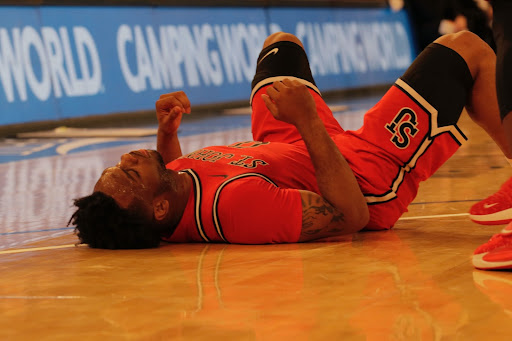There are a lot of great numbers that hang from the ceiling of Alumni Hall.
There’s 1952 and 1985, representing St. John’s advancement to the Final Four.
There’s 1943, 1944, 1959, 1965 and 1989 to announce the Redmen’s title victories in the National Invitational Tournament.
But for every 1986 and 2000 Big East Tournament or the dozens of other dates representing NCAA and NIT appearances, there are a few conspicuous absences.
Nowhere are there any mentions of the players who won those championships or appeared in the postseason.
Retired numbers are something special.
They are the ultimate honor an athlete receives, a proclamation that an individual was so outstanding that no future player should be allowed to wear that number.
Different schools have different guidelines in the selection process.
Kansas does not retire jerseys, but has honored those Jayhawks who were All-Americans.
Some of the most restrictive programs that have retired jerseys are Duke, which has retired 11, and UCLA, which has retired only six.
Some schools honor what seems like almost everybody and anybody. Kentucky does not put the numbers out of circulation, but has honored over 30 players.
It seems like the unwritten rule at North Carolina says that Tar Heels in the NBA gets their jersey hung in the Dean Dome.
But at St. John’s, the only men’s basketball-related banner belongs to Hall of Fame coach Lou Carnesecca, with the No. 526 – his career victory total.
Back in the 1980s a committee was formed under then-Athletic Director Jack Kaiser. Kaiser wanted to honor those players who had achieved greatness and one idea was to retire numbers.
But the committee eventually decided on a Hall of Fame room, where the inductees would be honored with a plaque entailing their athletic accomplishments.
The criteria was a five-year waiting period and the player couldn’t still be playing professionally.
Starting in 1984, the plaques would be placed in the Hall of Fame room in Alumni Hall. That space became offices, and the next choice, a part of the men’s basketball annex, became a faculty lounge.
The plan eventually stalled.
While there has been no stance against retiring numbers, it would seem to be a logical way to celebrate the history and tradition of St. John’s basketball.
Even now, there are certain numbers that are off-limits. Since Chris Mullin’s departure in 1985, no SJU player has been able to wear No. 20.
If the number isn’t going to be given out, then why not officially retire it?
In some cases, retiring a number will honor more than one player.
For example, Mark Jackson (1983-87) and Felipe Lopez (1994-98) both wore No. 13, and Walter Berry (1984-86) and Malik Sealy (1988-92) both wore 21.
No one on the current Red Storm roster wears either.
In certain cases, no one can wear the number again. Bob Zawoluk (1949-52), St. John’s fourth all-time leading scorer, wore No. 27, a number that is no longer allowed because jerseys can only contain combinations with digits from one-to-five.
One of the arguments against retiring numbers is posed in the question: Where to start?
There is close to 100 years of SJU basketball and there are many candidates for this honor. But after some careful research, it may not be as tough as it sounds.
First, John “Taps” Gallagher played before they even gave numbers out.
To commemorate his achievements from 1925-28, only his name needs to be on a banner.
Second, there is more than one case of a player wearing an illegal number.
Besides Zawoluk, Mike Parenti (1954-57) wore 27, Dick McGuire (1944, 46-49) wore 6, Dick Duckett (1951-53, 56-57) wore 16, Al McGuire (1948-51) wore 18 and Jack Garfinkle (1938-41) wore 19.
Hanging those numbers in the rafters poses no threat to an incoming freshman from choosing a number.
Third, because the school hasn’t retired jerseys, a number of great players have worn the same number.
Take the number 11. Gus Alfieri (1956-59), David Russell (1979-83), Billy Paultz (1968-70), Jayson Williams (1987-90) and Harry Boykoff (1943, 46-47) all wore it during their SJU careers. By retiring that one number, you could honor five of the greatest to play for the program.
The same with a number like 55 which is synonymous with names like Joe DePre (1967-70), Wayne McKoy (1977-81) and Lloyd “Sonny” Dove (1964-67).
Then there is 24 for the likes of George Johnson (1974-78), the school’s all-time leading rebounder, Tony Jackson (1958-61) and Bill Chrystal (1955-57).
Mullin’s No. 20 should be up there with both No. 13s – Jackson and Lopez.
And No. 21 doesn’t just stop at Sealy and Berry, but also includes the likes of Jack McMahon (1949-52).
As for the coaches, alongside Carnesecca should be the victory totals of Frank McGuire (106), James “Buck” Freeman (177) and Joe Lapchick (334).
There are so many other names, from Mel Davis (1970-72) to James White (1940-42), from Alan Seiden (1956-59) to Hy Gotkin (1943-45), that there isn’t enough space in this column to take each on a case-by-case basis.
For a program with such prestige and tradition, it’s time to for the present and future of St. John’s to honor the past.
Jason Della Rosa is a senior journalism major who had his No. 50 retired by his CYO basketball squad. Send comments to SJUTORCHSPORTS@aol.com.







